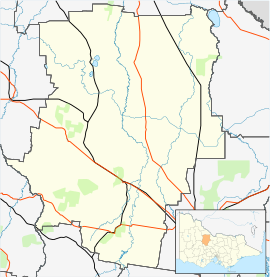Inglewood, Victoria
|
Inglewood Victoria |
|
|---|---|

Brooke Street, the town's main street
|
|
| Coordinates | 36°34′35″S 143°52′08″E / 36.57639°S 143.86889°ECoordinates: 36°34′35″S 143°52′08″E / 36.57639°S 143.86889°E |
| Population | 1,058 (2011 census) |
| Established | 1859 |
| Postcode(s) | 3517 |
| Location |
|
| LGA(s) | Shire of Loddon |
| State electorate(s) | Ripon |
| Federal Division(s) | Murray |
Inglewood is a town in Victoria, Australia, located on the Calder Highway in the Shire of Loddon. At the 2011 census Inglewood had a population of 1058 (up from 834 in 2006).
Inglewood was an important gold mining centre during the Victorian Gold Rush of the 1850s and 1860s.
Gold was first discovered in 1859 by Alexander, Joseph and Thomas Thompson and Joseph Hanny. On notification of the discovery some 16,000 diggers flocked to the area. By January 1860 a new field a few miles south of the original was opened up by Potter, Irvine and McKean and dubbed "New Inglewood". This is the site of the present township.
By mid-1860 the population on the field was estimated to be greater than 40,000, ranking among the biggest rushes in Victoria’s history.
The population soon dwindled as the easily won alluvial deposits became exhausted but, as early as 1859, quartz reefs had been discovered which resulted in the permanent settlement of a few thousand miners and businessmen.
The initial returns from the quartz reefs were significant. From the Columbian, 22 tons of stone crushed gave a return of over 2300 ounces of gold, one of the richest patches of gold recorded in the colony of Victoria. Numerous other reefs, including the Maxwell’s, Jersey, March and Morning Star, gained renown for their rich yields. In November 1860 there were 4,500 men employed in quartz mining, more than any other field at that time.
In 1861 the town was proclaimed a municipality and in 1863 the Borough of Inglewood was established. Self-government continued for 100 years until the borough was annexed to the Shire of Korong.
In December 1862 one of the most destructive fires recorded in the colony to that time occurred in the town’s main thoroughfare. A greater portion of the commercial precinct was burned to the ground, with damages estimated at over £100,000. The ultimate result of the fire was a transition from bark and canvass establishments to more substantial brick and iron structures, many of which remain today.
Around the turn of the 20th century, gold production began to diminish and a new form of employment was sought. The eucalyptus oil industry took hold when it was discovered that the leaves of the Blue Mallee, which grows abundantly around Inglewood but in few other places, produced some of the best quality eucalyptus oil in the world. In the early 20th century Inglewood became the centre for eucalyptus oil production in Victoria. The Valvoline Oil Company of the United States even had a distillery close to the town. The Inglewood district still produces the greater portion of Victoria’s eucalyptus oil.
...
Wikipedia

